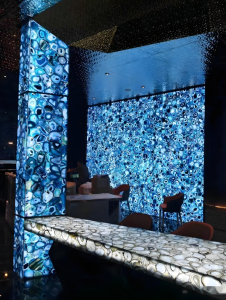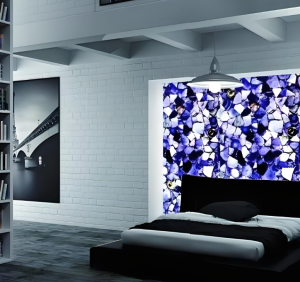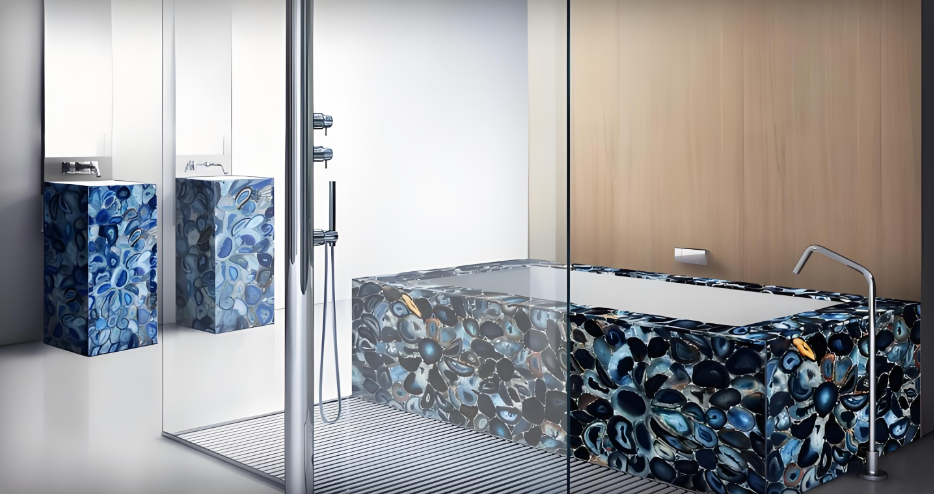Semi-precious stones, these miracles of nature, always attract people’s attention with their brilliant colors and unique charm. It is difficult to separate the real from the false in the brilliant gem market, nevertheless, since many imitations and treated gems are indistinguishable from the real ones. How thus can we separate the semi-precious stones from the depths of the ground amid the countless jewels? In this article, we will explore several common methods to distinguish the authenticity of semi-precious stones and reveal the secrets hidden behind the brilliance of gems.

Blue semi-precious stone slab
The luster of semi-precious stones: the battle between natural and artificial
The luster of semi-precious stones is one of the important indicators to judge their authenticity. Usually with their interior structure and chemical makeup, natural semi-precious stones have a distinctive shine. For example, the high refractive index of diamonds gives it an unparalleled sparkle, while the warm luster of jade comes from its fine fiber structure inside. Usually appearing overly glossy or drab, imitations cannot exactly copy these lusters. By observing the performance of the gem under different light, we can preliminarily judge its authenticity.
The secret of inclusions: the truth in flaws
Natural semi-precious stones are inevitably affected by the environment during their formation, forming some tiny inclusions or flaws. These inclusions are the “identity cards” nature provides for gemstones: bubbles, mineral particles, liquid inclusions. Artificial treated gemstones or imitations can lack these natural inclusions, or their distribution and form are aberrant. Therefore, observing the characteristics of the gemstones through a magnifying glass or microscope can help us distinguish their authenticity.
Hardness test: Toughness given by the earth
Mohs hardness is another important criterion for judgment. Their chemical composition and crystal structure define the hardness of various semi-precious stones, which varies. For instance, among natural minerals, diamond boasts a hardness of 10, the highest; quartz has a hardness of 7. A simple hardness test, such as gently scratching the surface of the gemstone with a piece of mineral of known hardness, can help us determine the type and authenticity of the gemstone. Real semi-precious stones usually do not have obvious scratches when facing such a test, while imitations are easy to leave marks.
Color Identification: Natural Color vs. Artificial Dyeing
The color of semi-precious stones is often one of their most attractive features, but it is also the part that is most easily imitated and processed. While artificially painted gemstones are homogeneous in color and even seem overly dazzling, natural gemstones are typically distinguished by different tones and slow transitions. By irradiating the gemstone with strong light or ultraviolet light, you can observe the changes and reactions of the color and further judge its authenticity. Under high light, for instance, natural jade will exhibit several tones of green; the color of dyed jade won’t alter all that much.

Bedroom background decorated with large slabs of semi-precious stones
Weight and Density: Earth’s Compression
Different semi-precious stones have different densities and weights due to their different compositions and internal structures. Gemstone density can be computed by weighing and measuring its volume; thereafter, it can be compared with known gemstone density statistics. This method can effectively identify imitations, because imitations often use low-density materials and weigh less than natural gemstones. If the weight of a gemstone of the same size is much lacking, it is probably a counterfeit or a treated gemstone.
Infrared Spectroscopy and UV Fluorescence: The Power of Science
In addition to physical testing, modern science and technology also provide us with many means to distinguish the authenticity of gemstones. While UV fluorescence reveals the internal composition and treatment traces of gemstones, infrared spectroscopy may identify their molecular structure, so helping to ascertain whether they are natural gemstones. For example, natural diamonds will emit blue fluorescence under ultraviolet light, while imitation diamonds usually do not have this reaction. By means of these scientific approaches, we can more precisely determine gemstone genuineness.
Thermal Conductivity Test: The Secret of Thermal Conduction
Different semi-precious stones have different thermal conductivity properties, which can be determined by thermal conductivity testing. For instance, whereas imitations like glass or synthetic cubic zirconia cannot accomplish this effect, diamonds have exceptionally great thermal conductivity and will rapidly transport heat when exposed to a heat source. Testing the heat conductivity of gemstones with a portable thermal conductivity meter will enable us to ascertain gemstone genuineness fast. This method is simple and effective and is often used for rapid identification of diamonds.
Spectral Analysis: The Story Behind the Color
Spectral analysis is another advanced gem identification method. Unique absorption lines in the spectrum of each semi-precious stone mirror the chemical composition and crystal structure of the gemstone. Gemstone authenticity and source can be found via spectrometer observation of light absorption at particular wavelengths. For example, natural sapphires will show specific absorption lines in the spectrum, while synthetic sapphires may lack these features. Spectral analysis gives us a scientific basis for gem identification and helps us to more thoroughly grasp the core of gemstones.
Consult with experts: the power of experience
Although we can preliminarily judge the authenticity of semi-precious stones through various tests and observation methods, it is sometimes still difficult to make an accurate judgment. See a professional gemologist or geologist at this period; it is the best decision. These professionals have professional tools and great experience to produce more consistent identification findings. In addition, regular jewelry stores and appraisal institutions usually provide gem identification services and issue appraisal certificates to provide us with protection for purchasing gemstones.

Luxurious space decorated with semi-precious stones
Identifying the authenticity of semi-precious stones is a complex subject that requires a combination of physical testing, chemical analysis and empirical judgment. Modern science and technology helps us to better distinguish natural gemstones from imitations by observing their brilliance, inclusions, hardness, color and density. Still, we could run across difficulties with some high-end imitations even using these techniques. Therefore, one should rely on the guidance of experts and pick respectable stores. Ultimately, real semi-precious stones are not only beautiful ornaments, but also treasures given by nature for billions of years, which are worthy of our careful identification and cherishment.
Frequently Asked Question (FAQ)
Are semi-precious stones expensive?
Yes, some semi-precious stones can be very expensive, and their value can be determined by a number of factors, including color, rarity, and quality. Among the most costly semi-precious stones are some such:
A semi-precious stone valued hundreds of dollars per carat, paraiba tourmaline
A semi-precious stone valued hundreds of dollars per carat, Alexandrite
Green Garnets: Also called Demantoid, this semi-precious stone can be valued hundreds of dollars per carat.
Morganite: A semi-precious stone worth a good lot per carat.
A semi-precious stone called peridot can be rather valuable per carat.
Natural occurring stones less rare and less costly than precious stones are called semi-precious stones. Diamond, sapphire, ruby, emerald are the four precious stones.
Among other semi-precious stones are:
Green Onyx, pearls, moonstones, rose quartz, aquamarine, amethysts, turquoise, Amazonite.





